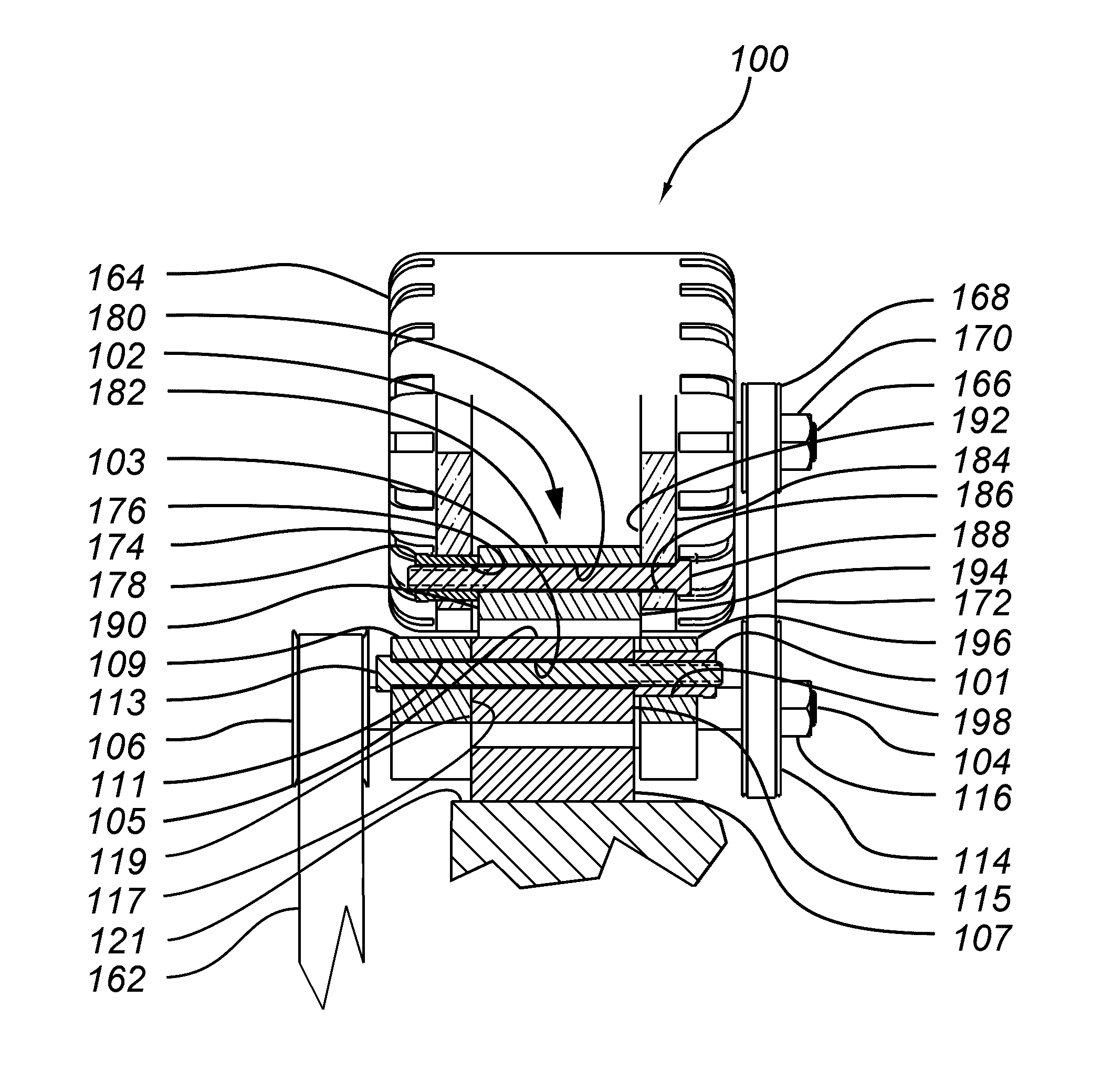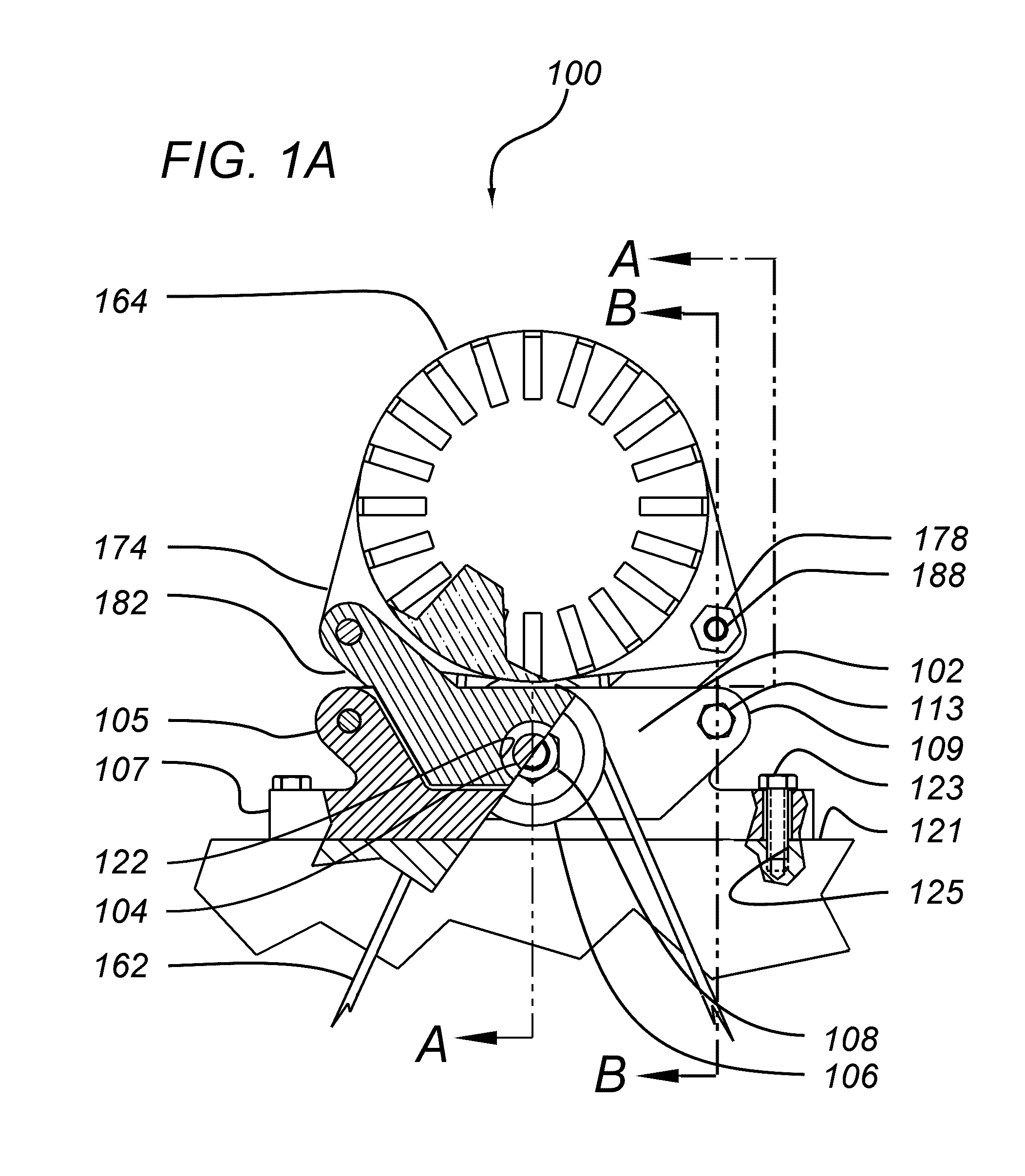Compact Torque Converter
a torque converter and compact technology, applied in the direction of machines/engines, manufacturing tools, manufacturing, etc., can solve the problems of increasing the diameter of the engine crank pulley, belt slippage, and insufficient hardware to properly align the components, so as to improve the functionality increase or decrease the rpm of the rotating machine, and increase power
- Summary
- Abstract
- Description
- Claims
- Application Information
AI Technical Summary
Benefits of technology
Problems solved by technology
Method used
Image
Examples
first embodiment
[0063]Referring now to FIGS. 1A-D, which are collectively referred to as FIGS. 1, a CTC assembly 100 comprises: a single shaft CTC body 102, a shaft 104 and a pulley 106. Pulley 106 is fixed to shaft 104 by nut 108 to press pulley 106 onto a shaft surface 110. Pulley 106 is also fixed to shaft 104 by a key 112. In certain applications the friction developed between pulley 106 and shaft surface 110 by nut 108 is sufficient to resist the torque developed by pulley 106 to eliminate the need for key 112. Press fitting or gluing pulley 106 onto shaft 104 can also be employed to fix pulley 106 adequately onto shaft 104.
[0064]CTC 102 body is preferably die-cast or sand-cast aluminum, such as type A356, but other suitable materials such as magnesium, steel, or engineered plastic such as polyamide-imide can be utilized. Alternatively, CTC 102 body can be machined from a solid billet of aluminum such as type 6061-T651 or other suitable material such as magnesium, steel, engineered plastic, or...
second embodiment
[0095]Referring now to FIGS. 3A-3E, which are collectively referred to as FIG. 3, a CTC assembly 300 comprises a twin shaft CTC body 302, a first shaft 304a, and pulley 306a, which is fixed to shaft 304a by nut 308a pressing pulley 306a onto shaft surface 310a. Pulley 306a is fixed to shaft 304a by key 312a. In certain applications the friction developed between pulley 306a and shaft surface 310a by nut 308a is sufficient to eliminate the need for key 312a. Press fitting or gluing pulley 306a onto shaft 304a can also be employed to fix pulley 306a adequately onto shaft 304a. Pulley 314a is maintained on shaft 304a by nut 316a compressing pulley 314a onto shaft surface 318a. Pulley 314a is fixed to shaft 304a by key 320a. In certain applications the friction developed between pulley 314a and shaft surface 318a by nut 316a is sufficient to eliminate the need for key 320a. Press fitting or gluing pulley 314a onto shaft 304a can also be employed to fix pulley 306a adequately onto shaft ...
third embodiment
[0110]Referring now to FIGS. 4A-4E, collectively referred to as FIG. 4, a CTC assembly 400 comprises CTC body 402, a shaft 404, and pulley 406 which is fixed to shaft 404 by nut 408 pressing pulley 406 onto shaft surface 410. Pulley 406 is fixed to shaft 404 by key 412. In certain applications, the friction developed between pulley 406 and shaft surface 410 by nut 408 is sufficient to resist the torque being developed eliminating the need for key 412. Press fitting or gluing pulley 406 onto shaft 404 can also be employed to fix pulley 406 adequately onto shaft 404. Pulley 414 is maintained on shaft 404 by nut 416 pressing pulley 414 onto shaft surface 418. Pulley 414 is also fixed to shaft 404 by key 420. In certain applications the friction developed between pulley 414 and shaft surface 418 by nut 416 is sufficient to eliminate the need for key 420. Press fitting or gluing pulley 414 onto shaft 404 can also be employed to fix pulley 406 adequately onto shaft 404.
[0111]CTC body 402 ...
PUM
| Property | Measurement | Unit |
|---|---|---|
| Fraction | aaaaa | aaaaa |
| Time | aaaaa | aaaaa |
| Force | aaaaa | aaaaa |
Abstract
Description
Claims
Application Information
 Login to View More
Login to View More - R&D
- Intellectual Property
- Life Sciences
- Materials
- Tech Scout
- Unparalleled Data Quality
- Higher Quality Content
- 60% Fewer Hallucinations
Browse by: Latest US Patents, China's latest patents, Technical Efficacy Thesaurus, Application Domain, Technology Topic, Popular Technical Reports.
© 2025 PatSnap. All rights reserved.Legal|Privacy policy|Modern Slavery Act Transparency Statement|Sitemap|About US| Contact US: help@patsnap.com



